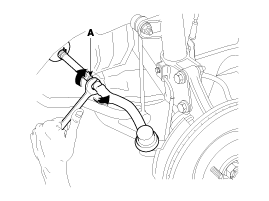Hyundai Creta: Tires/Wheels / Alignment: Repair procedures
Hyundai Creta GS 2014-2025 Service Manual / Suspension System / Tires/Wheels / Alignment: Repair procedures
| Front Wheel Alignment |
|
Toe
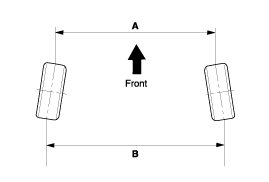
|
B - A > 0: Toe in
B - A < 0: Toe out
|
Toe Adjustment
| 1. |
Loosen the tie rod end lock nut.
|
| 2. |
Remove the bellows clip to prevent the bellows from being twisted.
|
| 3. |
Adjust the toe by screwing or unscrewing the tie rod. Toe adjustment
should be made by turning the right and left tie rods by the same amount.
|
| 4. |
When completing the toe adjustment, install the bellows clip and tighten
the tie rod end lock nut to specified torque.
|
Camber
|
Camber : -0.5°±0.5°
|
When the wheel tilts out at the top, then the camber is positive (+).
When the wheel tilts in at the top, then the camber is negative (-).
Camber and Caster are pre-set at the factory, so they do not need to be adjusted.
If the camber and caster are not within the standard value, replace or repair
the damaged parts and then inspect again.
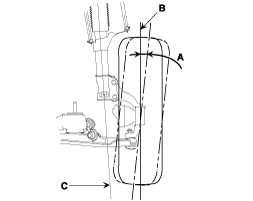
|
Item |
Description |
|
A |
Positive camber angle |
|
B |
True vertical |
|
C |
Strut centerline |
Caster
Caster is the tilting of the strut axis either forward or backward from vertical.
A backward tilt is positive (+) and a forward tilt is negative (-).
Caster is pre-set at the factory and doesn't need to be adjusted. If the caster
is not within the standard value, replace the bent or damaged parts.
|
Caster : 4.28°±0.5°
|
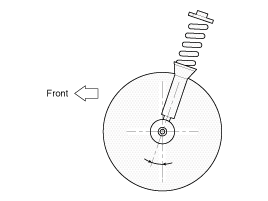
King-pin angle
|
King-pin : 13.21°±0.5°
|
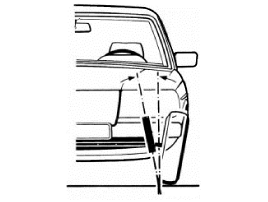
|
| Rear Wheel Alignment |
|
Toe

|
B - A > 0: Toe in (+)
B - A < 0: Toe out (-)
|
Toe is pre-set at the factory, so it does not need to be adjusted. If the toe
is not within the standard value, replace or repair the damaged parts and then
inspect again.
|
Toe
Total : 0.3°±0.2°
Individual : 0.15°±0.1°
|
Camber
Camber is pre-set at the factory, so it does not need to be adjusted. If the
camber is not within the standard value, replace or repair the damaged parts
and then inspect again.
|
Camber angle : -1.5°±0.5° 39
|
 Wheel: Repair procedures
Wheel: Repair procedures
Inspection
Hub nut tightening sequence
Tighten the hub nuts as follows.
Tightening torque (Front) :
88.25 ~ 107.9 N.m (9.0 ~ 11.0 kgf.m, 65.1 ~ 79.6 lb-ft ...
 Steering System
Steering System
...
Other information:
Hyundai Creta GS 2014-2025 Service Manual: Speakers: Repair procedures
Inspection
1.
Troubleshooting for Speaker
(1)
Basic inspection of speaker
Inspect the sound from speaker after verifying that the speaker
mounting screws is removed and the wiring connector is connected
precise ...
Hyundai Creta GS 2014-2025 Service Manual: Description and operation
Description
Burglar Alarm State [B/A State]
B/A State
Description
DISARM
1)
This is the state when "ARM" mode is off.
2)
If all doors or hoo ...
© 2017-2025 www.hcrmangs.com



